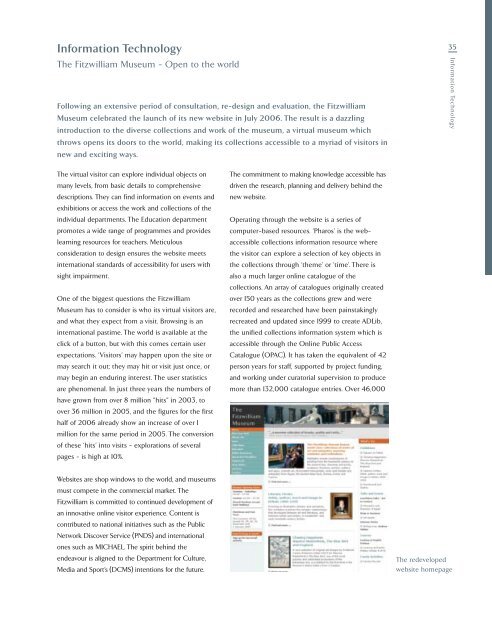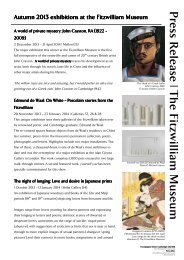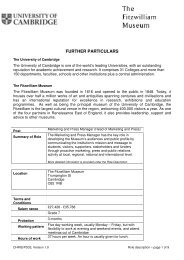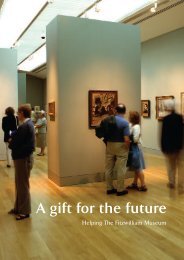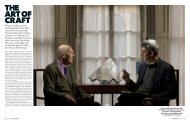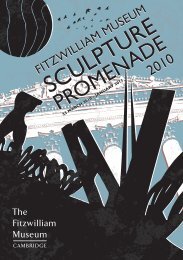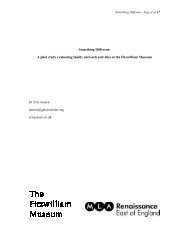The Fitzwilliam Museum - University of Cambridge
The Fitzwilliam Museum - University of Cambridge
The Fitzwilliam Museum - University of Cambridge
You also want an ePaper? Increase the reach of your titles
YUMPU automatically turns print PDFs into web optimized ePapers that Google loves.
Information Technology<br />
<strong>The</strong> <strong>Fitzwilliam</strong> <strong>Museum</strong> - Open to the world<br />
Following an extensive period <strong>of</strong> consultation, re-design and evaluation, the <strong>Fitzwilliam</strong><br />
<strong>Museum</strong> celebrated the launch <strong>of</strong> its new website in July 2006. <strong>The</strong> result is a dazzling<br />
introduction to the diverse collections and work <strong>of</strong> the museum, a virtual museum which<br />
throws opens its doors to the world, making its collections accessible to a myriad <strong>of</strong> visitors in<br />
new and exciting ways.<br />
<strong>The</strong> virtual visitor can explore individual objects on<br />
many levels, from basic details to comprehensive<br />
descriptions. <strong>The</strong>y can find information on events and<br />
exhibitions or access the work and collections <strong>of</strong> the<br />
individual departments. <strong>The</strong> Education department<br />
promotes a wide range <strong>of</strong> programmes and provides<br />
learning resources for teachers. Meticulous<br />
consideration to design ensures the website meets<br />
international standards <strong>of</strong> accessibility for users with<br />
sight impairment.<br />
One <strong>of</strong> the biggest questions the <strong>Fitzwilliam</strong><br />
<strong>Museum</strong> has to consider is who its virtual visitors are,<br />
and what they expect from a visit. Browsing is an<br />
international pastime. <strong>The</strong> world is available at the<br />
click <strong>of</strong> a button, but with this comes certain user<br />
expectations. ‘Visitors’ may happen upon the site or<br />
may search it out; they may hit or visit just once, or<br />
may begin an enduring interest. <strong>The</strong> user statistics<br />
are phenomenal. In just three years the numbers <strong>of</strong><br />
have grown from over 8 million “hits” in 2003, to<br />
over 36 million in 2005, and the figures for the first<br />
half <strong>of</strong> 2006 already show an increase <strong>of</strong> over 1<br />
million for the same period in 2005. <strong>The</strong> conversion<br />
<strong>of</strong> these ‘hits’ into visits - explorations <strong>of</strong> several<br />
pages - is high at 10%.<br />
Websites are shop windows to the world, and museums<br />
must compete in the commercial market. <strong>The</strong><br />
<strong>Fitzwilliam</strong> is committed to continued development <strong>of</strong><br />
an innovative online visitor experience. Content is<br />
contributed to national initiatives such as the Public<br />
Network Discover Service (PNDS) and international<br />
ones such as MICHAEL. <strong>The</strong> spirit behind the<br />
endeavour is aligned to the Department for Culture,<br />
Media and Sport’s (DCMS) intentions for the future.<br />
<strong>The</strong> commitment to making knowledge accessible has<br />
driven the research, planning and delivery behind the<br />
new website.<br />
Operating through the website is a series <strong>of</strong><br />
computer-based resources. ‘Pharos’ is the webaccessible<br />
collections information resource where<br />
the visitor can explore a selection <strong>of</strong> key objects in<br />
the collections through ‘theme’ or ‘time’. <strong>The</strong>re is<br />
also a much larger online catalogue <strong>of</strong> the<br />
collections. An array <strong>of</strong> catalogues originally created<br />
over 150 years as the collections grew and were<br />
recorded and researched have been painstakingly<br />
recreated and updated since 1999 to create ADLib,<br />
the unified collections information system which is<br />
accessible through the Online Public Access<br />
Catalogue (OPAC). It has taken the equivalent <strong>of</strong> 42<br />
person years for staff, supported by project funding,<br />
and working under curatorial supervision to produce<br />
more than 132,000 catalogue entries. Over 46,000<br />
35<br />
<strong>The</strong> redeveloped<br />
website homepage<br />
Information Technology


